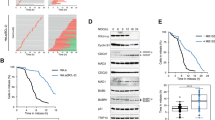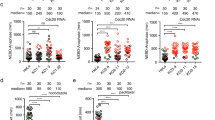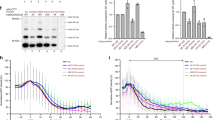Abstract
Separation of duplicated centrosomes (spindle-pole bodies or SPBs in yeast) is a crucial step in the biogenesis of the mitotic spindle. In vertebrates, centrosome separation requires the BimC family kinesin Eg5 and the activities of Cdk1 and polo kinase; however, the roles of these kinases are not fully understood. In Saccharomyces cerevisiae, SPB separation also requires activated Cdk1 and the plus-end kinesins Cin8 (homologous to vertebrate Eg5) and Kip1. Here we report that polo kinase has a role in the separation of SPBs. We show that adequate accumulation of Cin8 and Kip1 requires inactivation of the anaphase-promoting complex-activator Cdh1 through sequential phosphorylation by Cdk1 and polo kinase. In this process, Cdk1 functions as a priming kinase in that Cdk1-mediated phosphorylation creates a binding site for polo kinase,which further phosphorylates Cdh1. Thus, Cdh1 inactivation through the synergistic action of Cdk1 and polo kinase provides a new model for inactivation of cell-cycle effectors.
This is a preview of subscription content, access via your institution
Access options
Subscribe to this journal
Receive 12 print issues and online access
$209.00 per year
only $17.42 per issue
Buy this article
- Purchase on Springer Link
- Instant access to full article PDF
Prices may be subject to local taxes which are calculated during checkout







Similar content being viewed by others
References
Zimmerman, W., Sparks, C. A., & Doxsey, S. J. Amorphous no longer: the centrosome comes into focus. Curr. Opin. Cell Biol. 11, 122–128 (1999).
Nigg, E. A. Origins and consequences of centrosome aberrations in human cancers. Int. J. Cancer 119, 2717–2723 (2006).
Sterns, T. Centrosome duplication: a centriolar pas de deux. Cell 105, 417–420 (2001).
Jaspersen, S. L. & Winey, M. The budding yeast spindle pole body: structure, duplication and function. Annu. Rev. Cell. Dev. Biol. 20, 1–28 (2004).
Blangy, A. et al. Phosphorylation by p34cdc2 regulates spindle association of human Eg5, a kinesin-related motor essential for bipolar spindle formation in vivo. Cell 83, 1159–1169 (1995).
Lane, H. A. & Nigg, E. A. Antibody microinjection reveals an essential role for human polo-like kinase 1 (Plk1) in the functional maturation of centrosomes. J. Cell Biol. 135, 1701–1713 (1996).
Hoyt, M. A., He, L., Loo, K. K. & Saunders, W. S. Two Saccharomyces cerevisiae kinesin-related gene products required for mitotic spindle assembly. J. Cell Biol. 118, 109–120 (1992).
Lim, H. H., Goh, P. Y. & Surana, U. Spindle pole body separation in Saccharomyces cerevisiae requires dephosphorylation of the tyrosine 19 residue of Cdc28. Mol. Cell Biol. 16, 6385–6397 (1996).
Crasta, K., Huang, P., Morgan, G., Winey, M. & Surana, U. Cdk1 regulates centrosome separation by restraining proteolysis of microtubule-associated proteins. EMBO J. 25, 2551–2563 (2006).
Fitch, I. et al. Characterization of four B-type cyclin genes of the budding yeast Saccharomyces cerevisiae. Mol. Biol. Cell 3, 805–818 (1992).
Bishop, A. C. et al. A chemical switch for inhibitor-sensitive alleles of any protein kinase. Nature 407, 395–401 (2000).
Bartholomew, C. R. et al. Cdc5 interacts with the Wee1 kinase in budding yeast. Mol. Cell. Biol. 21, 4949–4959 (2001).
Zachariae, W., Schwab, M., Nasmyth, K. & Seufert, W. Control of cyclin ubiquitination by CDK-regulated binding of Hct1 to the anaphase promoting complex. Science 282, 1721–1724 (1998).
Hall, M. C., Warren, E. N. & Borchers, C. H. Multi-kinase phosphorylation of the APC/C activator Cdh1 revealed by mass spectrometry. Cell Cycle 3, 1278–1284 (2004).
Elia, A. E. H., Cantley, L. C. & Yaffe, M. B. Proteomic screen finds pSer/pThr-binding domain localizing Plk1 to mitotic substrates. Science 299, 1228–1231 (2003).
Nakajima, H., Toyoshima-Morimoto, F., Taniguchi, E. & Nishida, E. Identification of a consensus motif for Plk (polo-like kinase) phosphorylation reveals Myt1 as a Plk1 substrate. J. Biol. Chem. 278, 25277–25280 (2003).
Surana, U. et al. The role of CDC28 and cyclins during mitosis in the budding yeast S. cerevisiae. Cell 65, 145–161 (1991).
Yeh, E. et al. Spindle dynamics and cell cycle regulation of dynein in the budding yeast, Sacchromyces cerevisiae. J. Cell Biol. 130, 687–700 (1995).
Martinez, J. S., Jeong, D-E, Choi, E., Billings, B. M. & Hall, M. C. Acm1 is a negative regulator of the Cdh1-dependent anaphase-promoting complex/cyclosome in budding yeast. Mol. Cell. Biol. 26, 9162–9176 (2006).
Dial, J. M., Petrotchenko, E. V. & Borchers, C. H. Inhibition of APCCdh1 activity by Cdh1/ Acm1/ Bmh1 ternary complex formation. J. Biol. Chem. 282, 5237–5248 (2007).
Jaquenoud, M., van Drogen, F. & Peter, M. Cell cycle-dependent nuclear export of Cdh1p may contribute to the inactivation of APC/CCdh1. EMBO J. 21, 6515–6526 (2002).
Charles, J. F. et al. The Polo-related kinase Cdc5 activates and is destroyed by the mitotic cyclin destruction machinery in S. cerevisiae. Curr. Biol. 8, 497–507 (1998).
Castro, A., Bernis, C., Vigneron, S., Labbe, J.-C. & Lorca, T. The anaphase-promoting complex: a key factor in the regulation of cell cycle. Oncogene 24, 314–325 (2005).
Yeong, F. M., Lim, H. H., Wang, Y. & Surana, U. Early expressed Clb proteins allow accumulation of mitotic cyclin by inactivating proteolytic machinery during S phase. Mol. Cell Biol. 21, 5071–5081 (2001).
van Vugt, M. A. & Medema, R. H. Getting in and out of mitosis with Polo-like kinase-1. Oncogene 24, 2844–2859 (2005).
Dai, W., Wang, Q. & Traganos, F. Polo-like kinases and centrosome regulation. Oncogene 21, 6195–6200 (2002).
Yeong, F. M., Lim, H. H., Padmashree C. G. & Surana, U. Exit from mitosis in budding yeast: biphasic inactivation of the Cdk1–cyclin B2 mitotic kinase and the role of Cdc20. Mol. Cell 5, 501–511 (2000).
Winey, M. et al. Three-dimensional ultrastructural analysis of the Saccharomyces cerevisiae mitotic spindle. J. Cell Biol. 129, 1601–1615 (1995).
Acknowledgements
We are grateful to Janet Meehl and Michele Jones for their invaluable help with some of the experiments. We wish to thank David Morgan, Wolfgang Zachariae, Simonetta Piatti, Matthias Peter, Christopher Hardy and Kyung Lee for plasmids and strains, Mark Hall for valuable advice and Chee Peng Ng for help with electron microscopy. The work in MW laboratory was supported by NIH grant GM51312. U.S. is an adjunct faculty member of the Department of Pharmacology, National University of Singapore. The U.S. lab is supported by the Biomedical Research Council of A*STAR (Agency for Science, Technology and Research), Singapore.
Author information
Authors and Affiliations
Contributions
K.C. and L.H.H. performed all experiments; T.H.G. and M.W. carried out the electron microscopy analysis; U.S. and K.C. planned the project and analysed the data.
Corresponding author
Ethics declarations
Competing interests
The authors declare no competing financial interests.
Supplementary information
Supplementary Information
Supplementary Figures S1, S2, S3, S4, S5 and Supplementary Table S1 (PDF 604 kb)
Rights and permissions
About this article
Cite this article
Crasta, K., Lim, H., Giddings, T. et al. Inactivation of Cdh1 by synergistic action of Cdk1 and polo kinase is necessary for proper assembly of the mitotic spindle. Nat Cell Biol 10, 665–675 (2008). https://doi.org/10.1038/ncb1729
Received:
Accepted:
Published:
Issue Date:
DOI: https://doi.org/10.1038/ncb1729
This article is cited by
-
Bergenin, a PPARγ agonist, inhibits Th17 differentiation and subsequent neutrophilic asthma by preventing GLS1-dependent glutaminolysis
Acta Pharmacologica Sinica (2022)
-
Ubiquitin signaling in cell cycle control and tumorigenesis
Cell Death & Differentiation (2021)
-
APC/C is an essential regulator of centrosome clustering
Nature Communications (2014)
-
APC/C-Cdh1-dependent anaphase and telophase progression during mitotic slippage
Cell Division (2012)
-
Phosphorylation of Cdc5 regulates its accumulation
Cell Division (2011)



